load capacity Seat Altea Freetrack 2010 Owner's Manual
[x] Cancel search | Manufacturer: SEAT, Model Year: 2010, Model line: Altea Freetrack, Model: Seat Altea Freetrack 2010Pages: 294, PDF Size: 7.71 MB
Page 60 of 294
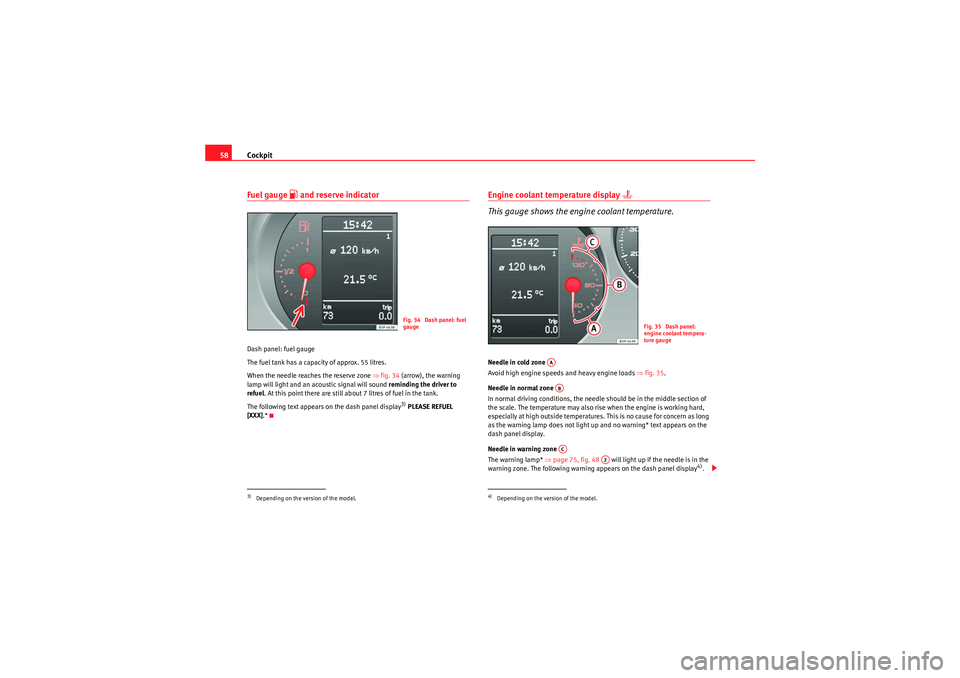
Cockpit
58Fuel gauge
and reserve indicator
Dash panel: fuel gauge
The fuel tank has a capacity of approx. 55 litres.
When the needle reaches the reserve zone ⇒fig. 34 (arrow), the warning
lamp will light and an acoustic signal will sound reminding the driver to
refuel . At this point there are still about 7 litres of fuel in the tank.
The following text appears on the dash panel display
3) PLEASE REFUEL
[XXX] .*
Engine coolant temperature display
This gauge shows the engine coolant temperature.
Needle in cold zone
Avoid high engine speeds and heavy engine loads ⇒fig. 35 .
Needle in normal zone
In normal driving conditions, the needle should be in the middle section of
the scale. The temperature may also rise when the engine is working hard,
especially at high outside temperatures. This is no cause for concern as long
as the warning lamp does not light up and no warning* text appears on the
dash panel display.
Needle in warning zone
The warning lamp* ⇒page 75, fig. 48 will light up if the needle is in the
warning zone. The following warning appears on the dash panel display
4).
3)Depending on the version of the model.
Fig. 34 Dash panel: fuel
gauge
4)Depending on the version of the model.
Fig. 35 Dash panel:
engine coolant tempera-
ture gauge
AAABAC
A2
Freetrack_EN.book Seite 58 Donnerstag, 10. September 2009 10:33 10
Page 190 of 294

Intelligent technology
188Brakes
What factors can have a negative effect on the brakes?New brake pads
New brake pads do not provide optimal performance during the first 400 km
they must be “run in”. However, the reduced braking capacity may be
compensated by pressing on the brake pedal a little harder. Avoid over-
loading the brakes during run-in.
Wear
T h e r a t e o f we a r o n t h e brake pads depends a great deal on how you drive and
the conditions in which the vehicle is operated. Negative factors are, for
instance, city traffic, frequent short trips or hard driving with abrupt starts
and stops.
Wet roads; road salt
When the velocity is over 80 km/h windscreen wipers are on, the brake
system moves the pads towards the brake discs for a few seconds. This
occurs - without warning to the driver - at regular intervals and requires a
more rapid response from the brakes when driving on wet roads.
In certain conditions, such as in heavy rain, or after washing the car or driving
through water, the full braking effect can be delayed by moisture (or in winter
by ice) on the discs and brake pads. The brakes should be “dried” by pressing
the pedal to restore full braking effect.
The effectiveness of the brakes can also be temporarily reduced if the car is
driven for some distance without using the brakes when there is a lot of salt
on the road in winter. In this case, the layer of salt on the brake discs and pads
has to wear off before braking.
Corrosion
There may be a tendency for dirt to build up on the brake pads and corrosion
to form on the discs if the car is used infrequently, or if you only drive low
mileages without using the brakes very much. If the brakes are not used frequently, or if rust has formed on the disks, it is
advisable to clean off the pads and disks by braking firmly a few times from a
moderately high speed
⇒.
Faults in the brake system
If the brake pedal travel should ever increase suddenly, this may mean that
one of the two brake circuits has failed. Drive immediately to the nearest qual-
ified workshop and have the fault rectified. On the way to the dealer, be
prepared to use more pressure on the brake pedal, and allow for longer stop-
ping distances.
Low brake fluid level
Malfunctions can occur in the brake system if the brake fluid level is too low.
The brake fluid level is monitored electronically.
Brake servo
The brake servo amplifies the pressure you apply to the brake pedal. The
brake servo works only when the engine is running.
WARNING
•When applying the brakes to clean off deposits on the pads and discs,
select a clear, dry road. Be sure not to inconvenience or endanger other
road users. Risk of accident.•Ensure the vehicle does not move while in neutral, when the motor is
stopped. Failure to do so could result in an accident.Caution
•Never let the brakes “drag” by leaving your foot on the pedal when you do
not really intend to brake. This overheats the brakes, resulting in longer stop-
ping distances and greater wear.•Before driving down a long, steep gradient, it is advisable to reduce speed
a n d ch a n ge to a l o w e r ge a r ( o r m o v e t h e s e l e c t o r le v e r t o a l o w e r g ea r p o s i t i o n
if your car has automatic transmission). This makes use of engine braking
Freetrack_EN.book Seite 188 Donnerstag, 10. September 2009 10:33 10
Page 273 of 294

General notes on the technical data271
Safety First
Controls and equipment
Practical tips
Technical Data
Data on fuel consumptionFuel consumption
The consumption and emission details shown on the vehicle
data sticker differ from one vehicle to another.The fuel consumption and CO
2 emissions of the vehicle can be found on the
vehicle data sticker.
The fuel consumption and emissions figures given are based on the vehicle
weight category, which is determined according to the engine/gearbox
combination and the equipment fitted.
The consumption and emission figures are calculated in accordance with the
EC test requirements 1999/100/EC. These test requirements specify a real-
istic test method based on normal everyday driving.
The following test conditions are applied:
Note
•Actual consumption may vary from quoted test values, depending on
personal driving style, road and traffic conditions, the weather and the
vehicle condition.WeightsKerb weight refers to the basic model with a fuel tank filled to 90% capacity
and without optional extras. The figure quoted includes 75 kg to allow for the
weight of the driver.
For special versions and optional equipment fittings or for the addition of
accessories, the weight of the vehicle will increase ⇒.
WARNING
•Please note that the centre of gravity may shift when transporting
heavy objects; this may affect the vehicle's handling and lead to an acci-
dent. Always adjust your speed and driving style to suit road conditions
and requirements.•Never exceed the gross axle weight rating or the gross vehicle weight
rating. If the allowed axle load or the allowed total weight is exceeded, the
driving characteristics of the vehicle may change, leading to accidents,
injuries and damage to the vehicle.
Urban cycle
The urban cycle starts with an engine cold start. City driving
is then simulated.
Extra urban
cycle
In the extra urban cycle simulation the vehicle frequently
accelerates and brakes in all gears, as in normal everyday
driving. The road speed ranges from 0 to 120 km/h.
To ta l co n-
sumption
The average total consumption is calculated with a weighting
of around 37% for the urban cycle and 63% for the extra
urban cycle.
CO2 emis-
sions
The exhaust gases are collected during both driving cycles to
calculate carbon dioxide emissions. The gas composition is
then analysed to evaluate the CO
2 content and other emis-
sions.
Freetrack_EN.book Seite 271 Donnerstag, 10. September 2009 10:33 10
Page 276 of 294
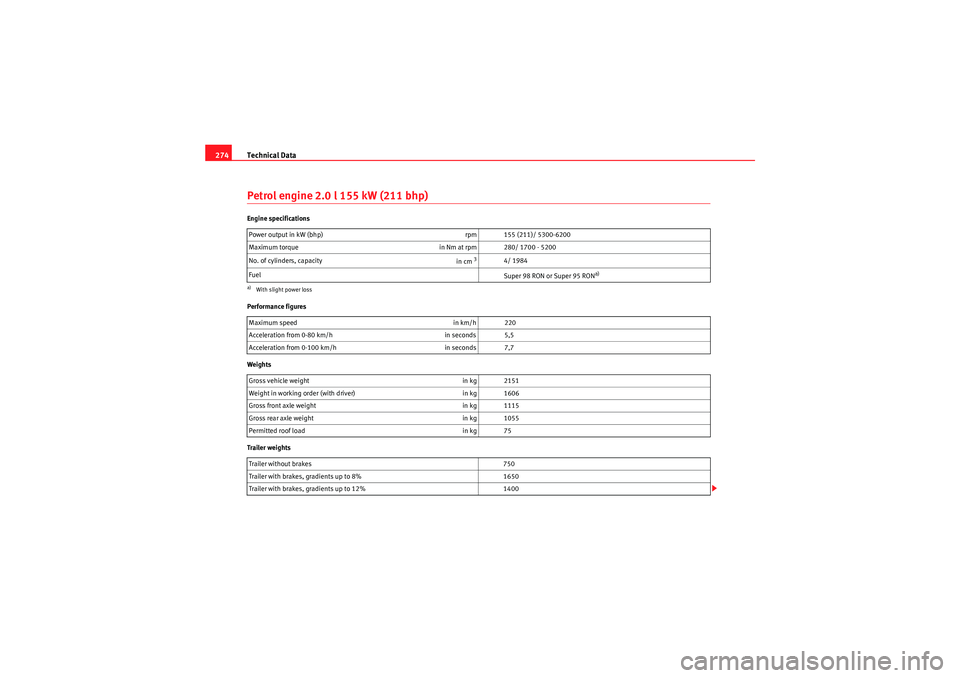
Technical Data
274Petrol engine 2.0 l 155 kW (211 bhp)Engine specifications
Performance figures
Weights
Trailer weights Power output in kW (bhp)
rpm 155 (211)/ 5300-6200
Maximum torque in Nm at rpm 280/ 1700 - 5200
No. of cylinders, capacity in cm
3
4/ 1984
Fuel Super 98 RON or Super 95 RON
a)
a)With slight power lossMaximum speedin km/h 220
Acceleration from 0-80 km/h in seconds 5,5
Acceleration from 0-100 km/h in seconds 7,7
Gross vehicle weight in kg 2151
Weight in working order (with driver) in kg 1606
Gross front axle weight in kg 1115
Gross rear axle weight in kg 1055
Permitted roof load in kg 75
Trailer without brakes 750
Trailer with brakes, gradients up to 8% 1650
Trailer with brakes, gradients up to 12% 1400
Freetrack_EN.book Seite 274 Donnerstag, 10. September 2009 10:33 10
Page 277 of 294
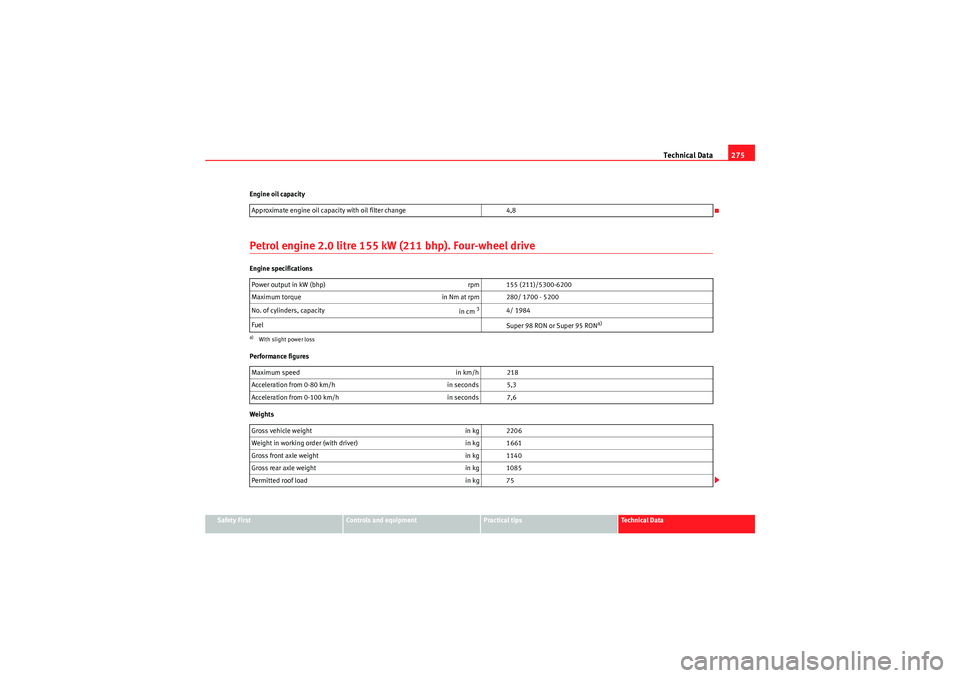
Technical Data275
Safety First
Controls and equipment
Practical tips
Technical Data
Engine oil capacity
Petrol engine 2.0 litre 155 kW (211 bhp). Four-wheel driveEngine specifications
Performance figures
Weights
Approximate engine oil capacity with oil filter change
4,8
Power output in kW (bhp) rpm 155 (211)/5300-6200
Maximum torque in Nm at rpm 280/ 1700 - 5200
No. of cylinders, capacity in cm
3
4/ 1984
Fuel Super 98 RON or Super 95 RON
a)
a)With slight power lossMaximum speedin km/h 218
Acceleration from 0-80 km/h in seconds 5,3
Acceleration from 0-100 km/h in seconds 7,6
Gross vehicle weight in kg 2206
Weight in working order (with driver) in kg 1661
Gross front axle weight in kg 1140
Gross rear axle weight in kg 1085
Permitted roof load in kg 75
Freetrack_EN.book Seite 275 Donnerstag, 10. September 2009 10:33 10
Page 279 of 294
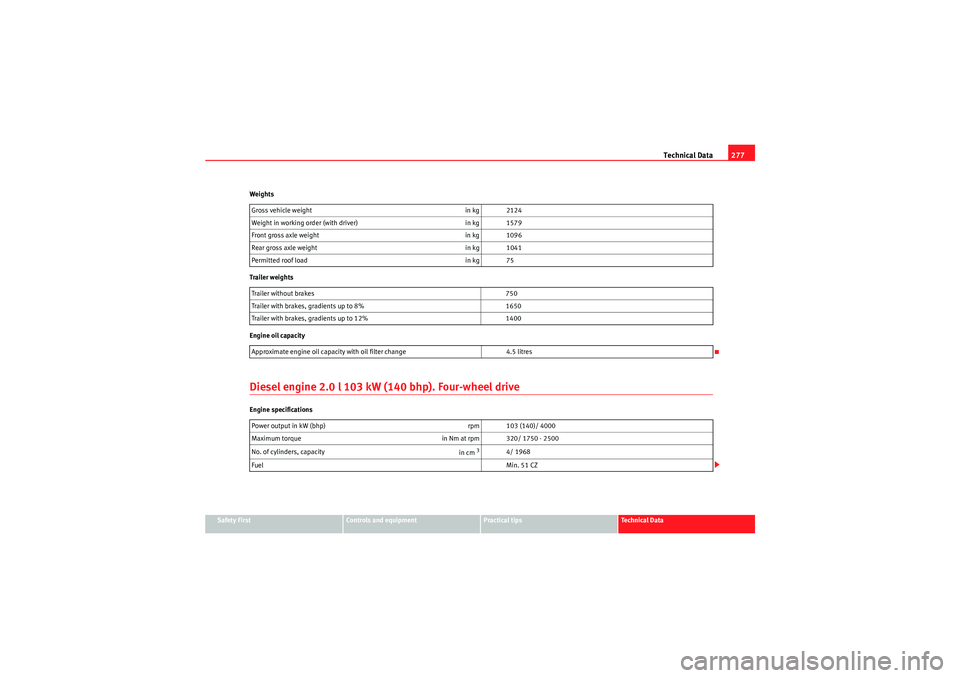
Technical Data277
Safety First
Controls and equipment
Practical tips
Technical Data
Weights
Trailer weights
Engine oil capacity
Diesel engine 2.0 l 103 kW (140 bhp). Four-wheel driveEngine specifications
Gross vehicle weight
in kg 2124
Weight in working order (with driver) in kg 1579
Front gross axle weight in kg 1096
Rear gross axle weight in kg 1041
Permitted roof load in kg 75
Trailer without brakes 750
Trailer with brakes, gradients up to 8% 1650
Trailer with brakes, gradients up to 12% 1400
Approximate engine oil capacity with oil filter change 4.5 litres
Power output in kW (bhp) rpm 103 (140)/ 4000
Maximum torque in Nm at rpm 320/ 1750 - 2500
No. of cylinders, capacity in cm
3
4/ 1968
Fuel Min. 51 CZ
Freetrack_EN.book Seite 277 Donnerstag, 10. September 2009 10:33 10
Page 280 of 294
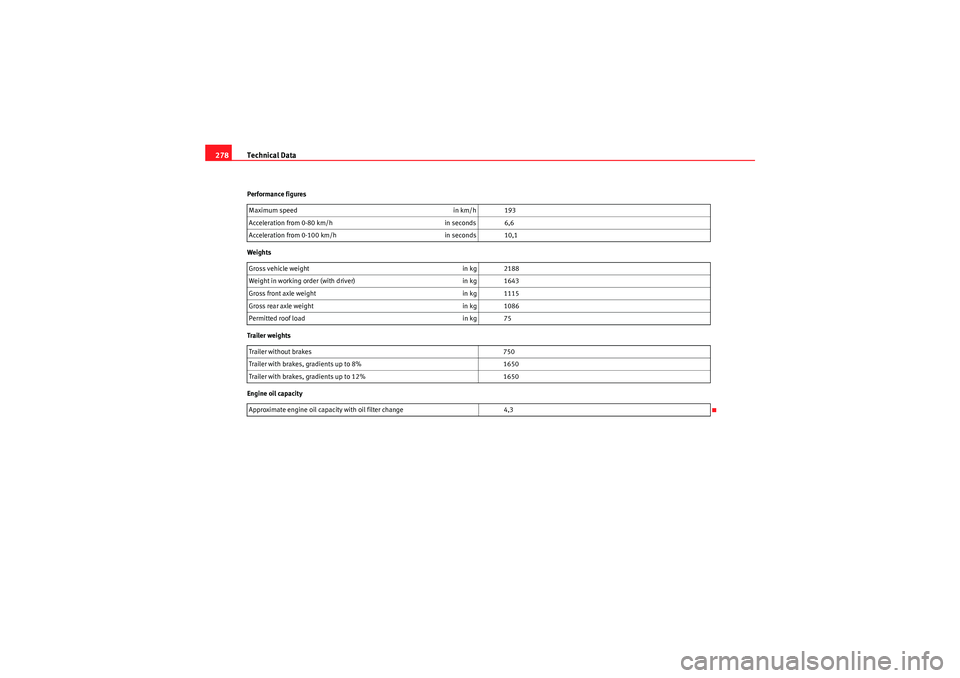
Technical Data
278Performance figures
Weights
Trailer weights
Engine oil capacity Maximum speed
in km/h 193
Acceleration from 0-80 km/h in seconds 6,6
Acceleration from 0-100 km/h in seconds 10,1
Gross vehicle weight in kg 2188
Weight in working order (with driver) in kg 1643
Gross front axle weight in kg 1115
Gross rear axle weight in kg 1086
Permitted roof load in kg 75
Trailer without brakes 750
Trailer with brakes, gradients up to 8% 1650
Trailer with brakes, gradients up to 12% 1650
Approximate engine oil capacity with oil filter change 4,3
Freetrack_EN.book Seite 278 Donnerstag, 10. September 2009 10:33 10
Page 281 of 294
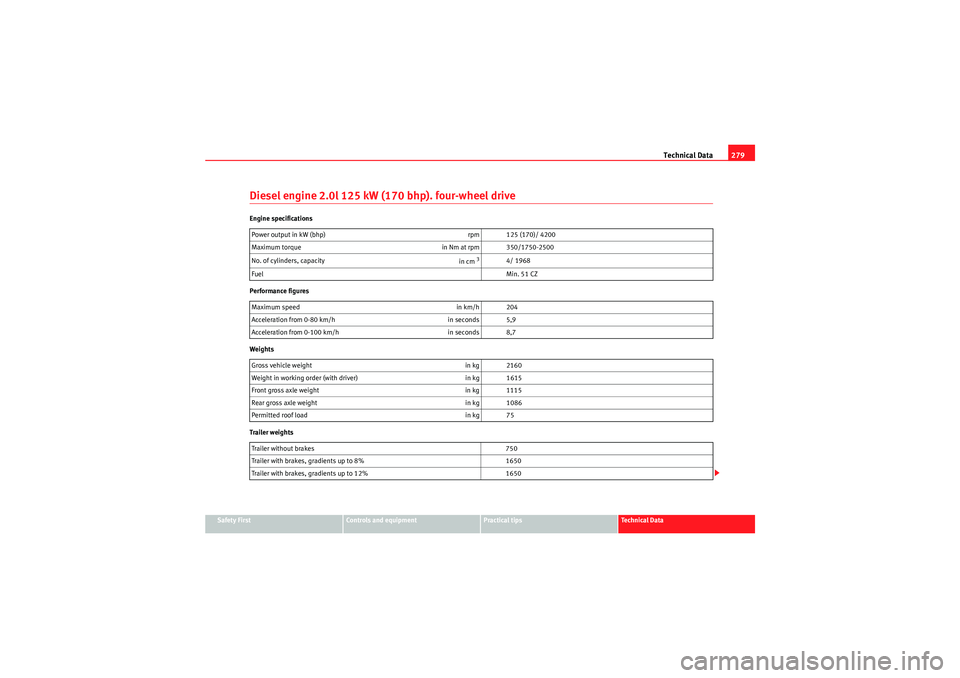
Technical Data279
Safety First
Controls and equipment
Practical tips
Technical Data
Diesel engine 2.0l 125 kW (170 bhp). four-wheel driveEngine specifications
Performance figures
Weights
Trailer weightsPower output in kW (bhp)
rpm 125 (170)/ 4200
Maximum torque in Nm at rpm 350/1750-2500
No. of cylinders, capacity in cm
3
4/ 1968
Fuel Min. 51 CZ
Maximum speed in km/h 204
Acceleration from 0-80 km/h in seconds 5,9
Acceleration from 0-100 km/h in seconds 8,7
Gross vehicle weight in kg 2160
Weight in working order (with driver) in kg 1615
Front gross axle weight in kg 1115
Rear gross axle weight in kg 1086
Permitted roof load in kg 75
Trailer without brakes 750
Trailer with brakes, gradients up to 8% 1650
Trailer with brakes, gradients up to 12% 1650
Freetrack_EN.book Seite 279 Donnerstag, 10. September 2009 10:33 10